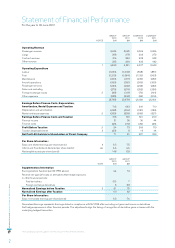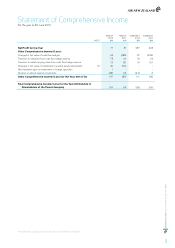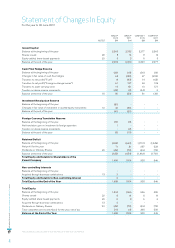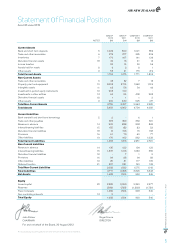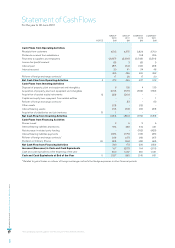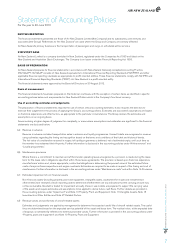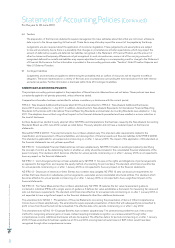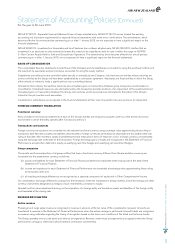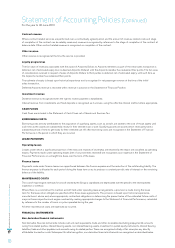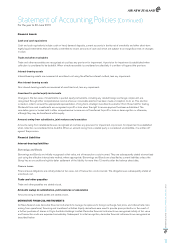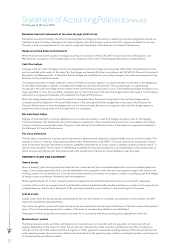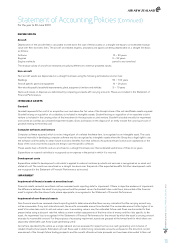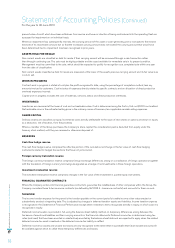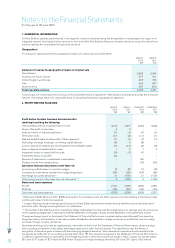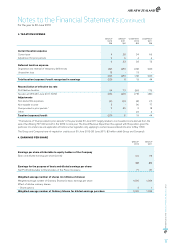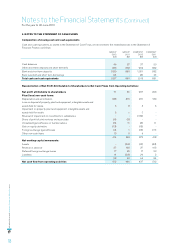Air New Zealand 2012 Annual Report Download - page 11
Download and view the complete annual report
Please find page 11 of the 2012 Air New Zealand annual report below. You can navigate through the pages in the report by either clicking on the pages listed below, or by using the keyword search tool below to find specific information within the annual report.
AIR NEW ZEALAND ANNUAL FINANCIAL RESULTS 2012
9
NZ IAS 27 (2011) - Separate Financial Statements has not been adopted early. NZ IAS 27 (2011) carries forward the existing
accounting and disclosure requirements for separate financial statements with some minor clarifications. The amendments, which
become effective for annual periods commencing on or after 1 January 2013, are not expected to have a significant impact on the
financial statements.
NZ IAS 28 (2011) - Investments in Associates and Joint Ventures has not been adopted early. NZ IAS 28 (2011) clarifies that an
investment in an associate or joint venture that meets the criteria to be classified as held for sale is within the scope of NZ IFRS
5 - Non-Current Assets Held for Sale and Discontinued Operations. The amendments, which become effective for annual periods
commencing on or after 1 January 2013, are not expected to have a significant impact on the financial statements.
BASIS OF CONSOLIDATION
The consolidated financial statements include those of the Company and its subsidiaries, accounted for using the purchase method, and
the results of its associates and joint ventures, accounted for using the equity method.
Subsidiaries are entities that are controlled either directly or indirectly, by the Company. Joint ventures are entities whose activities are
jointly controlled by the Group and have been established by a contractual agreement. Associates are those entities in which the Group,
either directly or indirectly, holds a significant but not a controlling interest.
All material intercompany transactions, balances and unrealised gains on transactions between group companies are eliminated on
consolidation. Unrealised losses are also eliminated unless the transaction provides evidence of an impairment of the asset transferred.
Unrealised gains on transactions between the Group, joint ventures and its associates are eliminated to the extent of the Group’s
interest in the joint ventures and associates.
Investments in subsidiaries are recognised in the financial statements at their cost of acquisition less any provision for impairment.
FOREIGN CURRENCY TRANSLATION
Functional currency
Items included in the financial statements of each of the Group’s entities are measured using the currency of the primary economic
environment in which the entity operates (the “functional currency”).
Transactions and balances
Foreign currency transactions are converted into the relevant functional currency using exchange rates approximating those ruling at
transaction date. Monetary assets and liabilities denominated in foreign currencies at the balance sheet date are translated at the rate
ruling at that date. Non-monetary assets and liabilities that are measured in terms of historical cost in a foreign currency are translated
using the exchange rate at the date of the transaction. Foreign exchange gains or losses are recognised in the Statement of Financial
Performance, except when deferred in equity as qualifying cash flow hedges and qualifying net investment hedges.
Group companies
The results and financial position of all group entities that have a functional currency different from the presentation currency are
translated into the presentation currency as follows:
(a) assets and liabilities for each Statement of Financial Position presented are translated at the closing rate at the date of that
Statement of Financial Position;
(b) income and expenses for each Statement of Financial Performance are translated at exchange rates approximating those ruling
at transaction date; and
(c) all resulting exchange differences are recognised as a separate component of equity and in Other Comprehensive Income.
On consolidation, exchange differences arising from the translation of the net investment in foreign entities, and of borrowings and other
currency instruments designated as hedges of such investments, are taken to equity.
Goodwill and fair value adjustments arising on the acquisition of a foreign entity are treated as assets and liabilities of the foreign entity
and translated at the closing rate.
REVENUE RECOGNITION
Airline revenue
Passenger and cargo sales revenue is recognised in revenue in advance at the fair value of the consideration received. Amounts are
transferred to revenue in the Statement of Financial Performance when the actual carriage is performed. Unused tickets are recognised
as revenue using estimates regarding the timing of recognition based on the terms and conditions of the ticket and historical trends.
The Group operates various code share and alliance arrangements. Revenue under these arrangements is recognised when the Group
performs the carriage or otherwise fulfils all relevant contractual commitments.
Statement of Accounting Policies (Continued)
For the year to 30 June 2012




